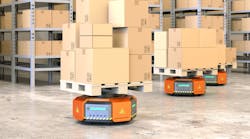Autonomous robots are real and they provide real value on the manufacturing floor. Is it part of your design plan? That’s one of the topics on the agenda at the Autonomous Mobile Robot Conference presented by the Robotic Industries Association (RIA) on Sept. 17 in Louisville.
Denise Ebenhoech, regional head of advanced robotic applications for KUKA Robotics, will discuss this issue and how autonomous mobile robots (AMRs) are being deployed in operations around the world during a session at the conference. Ebenhoech has been with KUKA since 2008, and in her current position she provides thought leadership for both KUKA and their customers on a wide range of topics, such as Industry 4.0, mobility, and human-robot collaboration.
In an interview with Machine Design, she discussed the current state of AMR deployment in manufacturing, the barriers to adoption, and what should get designers excited about the future of AMRs:
Machine Design: Talk about the market today for AMRs. Where are we today in terms of adoption, and where are we headed?
Denise Ebenhoech: I would say that we are in a very early stage of development and adoption because the technology is fairly new to many looking to integrate it into their processes. The technology itself has been around for a while, but the general awareness of its capabilities is just starting to gain traction. In terms of maturity, warehouse environments are a little further along. They have more open space. There are less people moving around, which makes the safety concept easier.
It’s much more difficult when you try to incorporate AMRs into production settings. There are a lot more variables to contend with, machines and systems to coordinate with, and sometimes very tight space to navigate. Not only do you have people and other traffic to deal with, the environmental makeup is continually changing. Advancements like omnidirectional wheels, SLAM navigation, and LIDAR sensors are making it easier to navigate these challenging terrains and will lead to increased adoption going forward.
MD: Your presentation at the RIA Autonomous Robotics event will focus on some of the case studies KUKA is involved with. What are some of the unique applications that you’re seeing as this market continues to evolve?
DE: In terms of unique, I think the introduction of KUKA’s KMR iiwa has opened the door to a host of applications that were not possible in the past. The combination of an omnidirectional platform with a sensitive, seven-axis robot provides a lot of flexibility for things like loading and unloading machines in tight areas. In the past, there have been AGVs with robots mounted on top of them, but they usually had to cage the robots, which slowed the process and neutralized the advantages of linking the two technologies together in the first place.
One of the areas where we’ve seen a perfect fit is in clean room applications. There’s not a lot of space in these environments, but the KMR iiwa’s compact platform, SLAM navigation, and omnidirectional wheels enable it maneuver through complex settings. The robot’s sensitivity and seventh axis provide added flexibility to handle delicate parts with maximum precision.
Denise Ebenhoech
MD: What are the barriers to adoption? Are they budget-related, or are there other factors?
DE: As with the introduction of any other transformative technology, I think the biggest barrier to adoption is often perception. Some will look at it and think it’s a great idea but will think they cannot afford it without checking. I also think the perception of complexity can be a hurdle. Sometimes, it’s just not possible due to space restrictions.
It’s just a new technology, and people have to get their head around it. This is not unlike automating a process. You have to think about what’s being done. Think about how it’s being done. This is easier if you have a warehouse management system or production management system. It’s just something where you have to connect the IT part. That’s where we are pretty open and flexible.
MD: From a designer standpoint, what are some of the opportunities for machine systems and applications? What applications should designers be more excited about?
DE: I think that the most exciting thing that autonomous mobile robots do for designers is enable them to break away from the concept of a traditional linear production line. Up until now, if you had a bunch of machines, you had to think in terms of having a certain machine next to another certain machine and so forth to optimize your processes, and if you had robots, they had to be at a fixed place in order to support the operations. And you could only do that specific process with the set-up. Making any changes to your production meant that you had move things around, which meant lengthy downtimes.
The AMRs provide a lot of flexibility that allows designers to think outside the box conceptually and get creative with a number of different applications. I think the technology lends itself more to structured environments with efficient production processes, but it can be adapted to an almost unlimited number of applications.
MD: What is the relationship between process design and manufacturing operations when it comes to AMRs? What should it be?
DE: Today, AMRs are mainly used to replace other existing transportation means like carts, forklift trucks, or conveyors. In these scenarios, the companies generally try to keep their processes the same. That being said, there are some companies that are starting to rethink their processes and manufacturing operations by incorporating the higher flexibility of the AMRs. Usually, that is the case when customers are planning new greenfield plants or trying to completely rethink their production processes to make them more efficient.
This thinking of incorporating more flexibility in process design and manufacturing operations through AMRs will become more common in the future. And with the line between mass manufacturing and mass customization increasingly blurring, technologies like these will only become more important in the production landscape.


